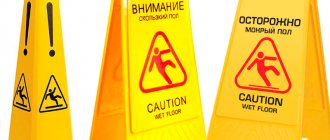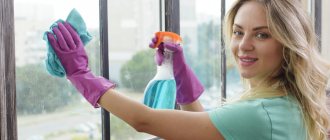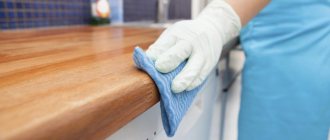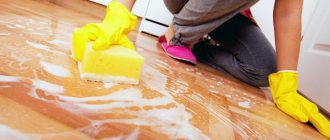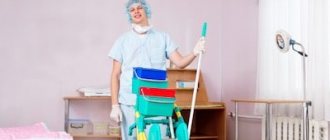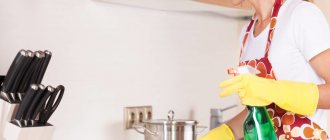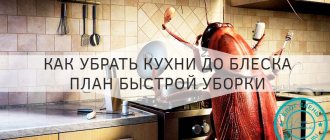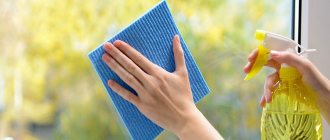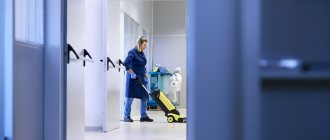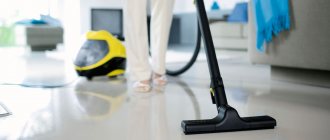Cleaning in a hospital is a constant process, since we are talking about a medical institution where the requirements for disinfection, asepsis and antiseptics are very high. According to sanitary and epidemiological standards, each hospital room should be cleaned using a certain technology using disinfectant solutions and cleaning equipment allocated individually for each room.
- Types of hospital cleaning
- Cleaning rooms in a hospital
- Cleaning corridors in a hospital
- Hospital cleaning solutions
Routine and general cleaning in a medical facility can only be carried out by specially trained and qualified personnel.
Types of cleaning and their characteristics
1. Routine cleaning. Routine cleaning is carried out in all premises of medical institutions with different frequency and in different modes.
- Operating rooms. The mode is virucidal (antiviral, or ensures the death of viruses on surfaces and in the air), the frequency of current cleanings is after each operation.
- Canteens, buffets and distribution areas. The mode is virucidal, the frequency is after each distribution of food.
- Maternity rooms. The regimen is virucidal, the frequency is 3 times a day.
- Aseptic rooms (manipulation rooms, treatment rooms, dressing rooms, examination rooms), wards, dirty linen. The regimen is virucidal, the frequency is 2 times a day.
- Administrative and utility premises. The mode is bactericidal (ensuring the death of bacterial microflora on surfaces and in the air).
1.1 Preliminary cleaning. Wet surface treatment is carried out before the start of the working day; it is a type of routine cleaning of the premises before starting work if necessary.
2. Final cleaning (final disinfection). It is carried out in case of detection of an infectious disease in the source of infection after the patient is discharged, transferred to another department or death. The regimen is in accordance with the methods of sanitization for the infection that is detected in the patient. It is carried out once in a specific room (most often in a ward).
3. General cleaning. It is carried out for the purpose of highly effective cleaning and disinfection of the surface of premises in health care facilities. The frequency of general cleaning of aseptic premises is once a week, of other premises - at least once a month.
Apartment cleaning checklist so you don’t forget anything
Surely you have heard more than once: “It is clean not where they clean, but where they do not litter.” We believe that this is only partly true, because even in an empty apartment dust accumulates, and in ordinary life all kinds of pollution cannot be avoided. Therefore, we offer a new version of the famous phrase: “Clean where they put things in order in a timely manner and maintain it correctly.” At the same time, we will offer sample checklists for cleaning an apartment in different situations.
Prepare your inventory
Cleaning checklists can be considered a waste of time. But if you stock them once, you can achieve several goals at once:
- Repeat cleaning regularly where necessary. For example, if you wipe the kitchen cabinets and hood once every two weeks, they simply will not have time to become covered with dirt that is difficult to remove.
- Organize your work and prioritize. This way you won’t have to grab everything at once on the weekend, but wash the curtains first and only take care of the windows a week later.
- Understand what tools and resources are needed. If you plan to wash your windows in three weeks, it’s time to buy a brush or a special mop. And you can involve someone close to you to remove dust on the shelves. By the way, you have time to motivate them and think about how to organically integrate this into their daily routine.
Let's talk about tools in more detail. You definitely shouldn’t skimp on them, especially since these days many original solutions for various types of cleaning have been invented and created. Of course, you can get by with just rags and water, but then you will have to spend much more time, and it is unlikely that you will be able to achieve an ideal result.
Therefore, let's start with a kind of checklist for preparing cleaning equipment. Minimum set:
- tools - bucket, mop, brush and dustpan, roller for cleaning textiles. Of course, a lot depends on your habits, but if you feel that you lack a convenient scoop or window cleaning tools, try to purchase them;
- materials - rags, sponges, mops, household napkins, garbage bags;
- cleaning products for kitchen equipment, plumbing, removing blockages in pipes;
- cleaning compositions for dishes, glass and mirrors, floors, upholstered furniture;
- laundry detergents - powder or gel, bleach, stain remover, conditioner.
Keep cleaning equipment in a separate utility cabinet and replenish this arsenal periodically (for example, once a month). This way everything will be at hand at the right time.
Please note: this is a basic set. Of course, a vacuum cleaner, a window cleaning robot, an air humidifier and other equipment will not be superfluous. But even a minimal set of products is enough to clean things up. In the catalog on the VkusVilla website you can read customer reviews about cleaning products and find out proven life hacks.
If you have long wanted to try eco-friendly household chemicals that are not tested on animals, read the material “Ethical beauty and refusal to test on animals: the experience of China, Russia and Europe.”
Here's what customers write about the plumbing cleaner:
“I use plumbing cleaner to clean toilets and sinks. A compact bottle, nevertheless with a sufficient volume of product, a convenient thin “spout” at the neck, a child-proof cap. It cleans perfectly, it says that it destroys all germs, and the smell of the product is not sharp, calm and even pleasant. It washes off well and doesn't foam much. The characteristics are not inferior to Western analogues, except that they are cheaper.”
Here is a review of the floor and surface cleaner:
“I liked the product. Non-aggressive composition, no obsessive odors, foams well. It copes with the main task, without stickiness or streaks.”
Make a cleaning plan
Let us remind you again why drawing up a checklist for current cleaning is more convenient than spontaneous battles for cleanliness in the house. If you have ever worked in an office, you have probably noticed that from time to time a message appears on the refrigerators in the common kitchen: “Please take away all the food, we will clean the refrigerator.” And this is also a checklist. How else - if not regularly and sparklingly - to keep refrigerators with so many containers and products clean?
So, the plan (aka checklist) depends on the type of work. And the list of tasks for general cleaning will be much longer than for everyday cleaning. To make it easier for you to create such a list for self-control, we have prepared universal checklists for different types of cleaning.
Daily cleaning checklist
The shortest checklist for daily cleaning will be. It helps maintain a carefully maintained order. In such a plan, be sure to include the following items: make the beds, ventilate the rooms, wipe off the dust, wash the dishes and sinks, take out the trash. What other activities to add to your quick cleaning checklist for every day depends on your lifestyle. For reference, take a look at our version.
Monday (Tuesday, Wednesday, Thursday, Friday - any weekday, the set of actions can be changed):
- make the bed
- take out the trash
- to wash the dishes
- wipe the stove, facades, cutting table
- tidy up the table in front of the mirror
- load laundry
- iron the laundry
- To water flowers
Or you can make a checklist for daily cleaning on weekdays, where unmarked items are performed daily:
- make the bed
- take out the trash
- to wash the dishes
- water the flowers (Monday)
- wipe the stove, facades, cutting table (Tuesday)
- clean up the table in front of the mirror (Wednesday)
- load urgent laundry (Thursday)
- dust off (Thursday)
- iron the laundry (Friday)
This list is already close to a checklist for the week, but the latter will be more voluminous, so it is better to keep it separately.
Weekly apartment cleaning checklist
Next, we make a checklist for cleaning the apartment for the week. Here, to the tasks from the “quick list” for each day, you need to add changing bed linen, caring for indoor plants, cleaning kitchen appliances and plumbing fixtures in the bathroom and toilet, washing and ironing, removing dust from chandeliers and cabinets, using a vacuum cleaner and washing floors, and others tasks important for your comfort.
You will again find tips in the basic checklist, and then supplement the plan, guided by your life experience. Here again you can highlight regular tasks and what needs to be done 1-2 times a month.
Apartment cleaning checklist for a week/month:
- change bed linen
- wash the plumbing
- vacuum and/or wash door and bathroom rugs
- change towels
- wipe the mirrors
- sort out food in the refrigerator
- order/buy groceries for the week
- vacuum and/or wash the floor
- Vacuum carpets on walls / dust on cabinets
- order/buy household chemicals (first Saturday of the month)
- wipe chandeliers and lamps (first Sunday of the month)
- clean the refrigerator (second Saturday of the month)
- wash the microwave, oven (second Sunday of the month)
- wash curtains (third Saturday of the month)
- clean drains under sinks (third Sunday of the month)
- clean/vacuum upholstered furniture (fourth Saturday of the month)
- wash house flowers (fourth Sunday of the month)
Take note of new household chemicals and cleaning products. For example, instead of newspapers when washing windows, you can use microfiber cloths, and avoid conditioner altogether when washing if the powder itself makes the laundry soft. Here's what customers write about one of these universal washing powders:
“The cute box with a bright design immediately caught my eye in the store, and its contents also met all expectations! The powder itself is packed inside in a bag, which is convenient: even if the box gets wet, nothing will happen to it. It comes with a cardboard measuring spoon, which is convenient. After washing, the laundry is clean, fresh, without unnecessary odors, soft without the addition of conditioner (the powder already contains a conditioning additive). The weight of the powder is 1 kg, you need 30–60 g per wash. Enough for a long time! I recommend purchasing."
For more useful tips on cleaning your home, kitchen, bathroom and toilet, see the material “Cleanliness Life Hacks. Review of environmentally friendly household chemicals."
An apartment cleaning checklist for every day is also convenient when preparing for holidays or receiving guests. If you distribute all the tasks over the week, you won’t have to spend the whole day on the eve of the event with a rag and a vacuum cleaner and fall exhausted in the evening. When the dust is removed, the shelves are in order, the kitchen and plumbing are cleaned, all that remains is to prepare the food in advance and think about how to set the table.
Checklist for general cleaning of the apartment
Each new season is a reason to refresh your memory on the general cleaning checklist for your apartment. Here again we add important steps to the previous list. You will need to put in order and put away seasonal clothes and shoes, thoroughly ventilating the closets before doing this. You need to wash the windows, grilles on ventilation holes and heating radiators, tiles in the bathroom, kitchen apron and appliances, wash and iron curtains and bedspreads (if you did not do this as part of the monthly checklist). We also need to conduct an audit and throw away the accumulated trash. (How it appears in the house even with regular cleaning is beyond belief!)
Of course, if you followed the weekly/monthly checklist, spring cleaning will be easier. This is the point of lists: when you keep order locally, garbage, dirt and dust do not have time to accumulate. As a result, the general cleaning checklist should only include things that, in principle, should not be done too often.
Example of a spring cleaning checklist
Kitchen, dining room:
- wash windows, slopes, window sills, mosquito nets, if necessary, wash and iron curtains
- sort out kitchen cabinets, clean shelves
- wash kitchen facades (if you don’t do this once a week/month)
- clean the hood, ventilation, batteries
- wash the floor and baseboard, including in hard-to-reach places, with detergent
- wash chairs, table legs
- clean the chandelier and lamps (if you don’t do this once a month)
Bathroom, toilet:
- unpack things in closets, clean shelves
- disinfect the toilet, brush, floor
- wash the walls, the seams between the tiles
- clean the washing machine
- wash doors, sockets, lamps
- clean the sink drain (if you don’t do it once a month)
Living room:
- take things apart in closets, wipe down shelves
- Vacuum upholstered furniture, if necessary, go to dry cleaning
- remove dust from cabinets, sweep or wipe walls
- wash mirrors, glass doors and shelves
- remove dust from household appliances and electronics
- clean sockets, radiators, lamps
- wash the floor and baseboards in hard-to-reach places
- clean bedspreads, blankets, carpets
- wash the windows and chandelier, wash the curtains (if you haven’t done this more often)
Bedroom/children's room:
- take things apart in closets, wipe down shelves
- wash pillows, blankets, blankets
- remove dust from cabinets, sweep or wipe walls
- clean window, radiator
- wash the curtains (if you don’t do it once a month)
- Vacuum the furniture and, if necessary, have the covers or individual items dry-cleaned
A separate line should include washing and washing children's toys. Read more about this in the material “How to properly wash and disinfect children’s toys.”
Want a life hack? When ironing interior textiles during general cleaning after washing, use special water rather than ordinary water to moisten it. Here's what VkusVilla buyers say about this method:
“Flavored iron water allows you to perfectly iron even very dry laundry and gives it a delicate apple aroma. Does not leave stains on fabric. Flavored water prevents the formation of scale on the heating elements of the iron, extending its service life.”
We by no means consider our instructions to be ideal, but suddenly they will be able to set the right vector for your thoughts about simplifying your life. For example, you can take the proposed files as a basis and, taking into account your needs, create a cleaning checklist for every day of the week or for each room: bedroom, living room, nursery, kitchen, bathroom.
Step-by-step plans and cleaning checklists help involve family members in the process. Having received clear cleaning instructions, your household will no longer be able to say that they don’t know what to do. And when they clean things up themselves, they will try to keep it longer.
Useful tips for home cleaning
There are hundreds, if not thousands, of lifehacks for home cleaning. It is impossible to collect them all in one article. Therefore, we will present only basic tips.
3 cleaning tips
- When cleaning a room, move from top to bottom. Remove dust and dirt from lamps, furniture, walls, window sills and frames, mirrors and window glass, and household appliances. Spray and water indoor flowers. Finally, vacuum and mop the floors.
- If you have an animal in the house, it is important to wash its bowls, tray, cage or other items daily, otherwise you will not avoid unpleasant odors in the house.
- First, clean the loggias and balconies, then the living rooms in the order that is convenient for you. Then put things in order in the kitchen and in the hallway (hallway). Finish the process by cleaning the bathroom.
2 Tips for Keeping Clean
- Always put things in their designated places to avoid cluttering the space with discarded clothes, toys and other items. It is necessary that all household members follow the rule. Even a small child needs to be explained that after playing, all cars, cubes, and dolls must occupy their drawers or shelves.
Let us note in passing that when decorating the interior, it is worth thinking about whether you really need the things you are going to buy, whether they will become “dust collectors” instead of decorating the house. All kinds of vases and figurines of intricate shapes are quite tedious to wipe, and dust accumulates quickly in small curls and details.
- When something is spilled or spilled, something is dirty or trampled somewhere, remove it immediately - it is difficult to deal with old stains, but fresh ones are almost always removed without problems.
When cleaning, do not forget about your own health. It is important to protect the skin of your hands from the harmful effects of dirty water and household chemicals. Polymer gloves can easily handle this. If you use hazardous compounds with volatile substances and a strong odor, it is advisable to wear a household respirator. After cleaning, thoroughly ventilate all rooms so that no chemical odors remain.
Surely you have your own life hacks for cleaning the house. Tell us in the comments.
Cleaning equipment: use and storage
Cleaning equipment must be stored in a specially designated room with an area of at least 4 square meters. All carts, buckets, mops, mops, containers and other containers must be clearly labeled or color coded. In the case of color coding, a table with its decoding should be located in the inventory storage room.
- Equipment for cleaning toilets is marked in red!
According to the marking, each item of equipment is used taking into account the functional purpose of the premises and the types of cleaning work. Cleaning equipment for floors and walls should be separate. For aseptic rooms, manipulation rooms and utility rooms, equipment should also be separate and stored in separate places designated for this purpose.
- In no case should the equipment for security offices, wards, administrative and utility rooms and toilets overlap!
- Using equipment for purposes other than its intended purpose is not permitted!
“Dry” cleaning using brooms and brushes is not carried out in medical institutions. The use of vacuum cleaners is only permitted for cleaning carpet or floor surfaces in medical departments or administrative areas.
Read also: Identification of a patient with acute infectious diseases: actions of medical workers
Personnel training
There is a hierarchy in the housekeeping department, which is responsible for cleaning. At the very first level there are maids, then there are supervisors, and after them there is the head of the department, Nadezhda.
Before a new maid starts work, she must undergo training - theoretical and practical. Training takes place in small groups under the guidance of a supervisor, who brings the maids into the room and himself cleans in the correct order. Next, the maids try to clean it themselves.
The duration of training for maids depends on the availability of work experience and its duration. As stated in hotel standards, a maid can undergo re-training with a supervisor if she feels insecure.
Despite the length of service and experience, each maid has in her cart this diagram, which prescribes the correct plan of action.
“Each hotel complex has its own cleaning standards. Thanks to our standards, which I described, the cleanliness level for the past year is 88%,” which means that 88% of guests noted in their reviews that their room was perfectly clean.
Carrying out current cleaning: algorithm
Let's give an example, let's look at routine cleaning in a hospital room. Before you are ready-made instructions.
- Familiarize yourself with the technological map for cleaning wards.
- Prepare cleaning equipment, check the completeness of the cleaning cart. Roll the cart to the entrance to the room.
- Politely ask the patient to remove personal belongings that interfere with cleaning (from window sills, bedside tables, floors) and to leave the room while cleaning is being carried out.
- Remove household waste from the room.
- Start wet cleaning and disinfection of surfaces using a “blue” napkin. Surface treatment begins on the opposite side of the beds, includes pieces of furniture and window glass (at arm's length), window sill, upper surface of the radiator, installation for ultraviolet air irradiation. When moving from one surface to another, the napkin turns over. Using one side of a napkin for two or more surfaces is prohibited.
- Start treating the surfaces in the bed area. First of all, wipe the console above the bed. If there are two beds in the room, then the right half of the console is wiped with one side of the napkin, the left half with the other. Then the bedside tables are processed. The bed in this area is wiped last.
- After disinfection of surfaces in the ward is completed, switches, door handles (entrance door handles - on both sides, toilet door handle - only on the ward side), ventilation grilles in doors (at the entrance door - on both sides, at the toilet door - only on the ward side) are thoroughly cleaned. side of the chamber).
- Wipe down chairs, including legs.
- After finishing cleaning the surfaces in the room, throw the napkin into a bag for used napkins.
- Pour cleaner into the toilet.
- Take a “red” napkin from the container with red markings and start cleaning the toilet.
- If the washbasin is located in the airlock of the room, then it is wiped first. Wipe surfaces from top to bottom: mirror, shelf, soap dispenser, antiseptic, sink.
- Cleaning the toilet begins with the heated towel rail, shower head, mount for the shower head, hose, then in the washbasin area (mirror, shelf, soap dispenser, sink). When moving from one surface to another, the napkin turns over. Using one side of a napkin for two or more surfaces is prohibited.
- Treat the ventilation grille on the door and the door handle.
- The toilet area is cleaned last. First the handrail, then the toilet.
- The “red” napkin is discarded into a used napkin bag.
- Take a floor mop with a red marking, put a mop with a red marking on it. Treat the floor in the toilet: first the baseboards, then the central part of the floor, without removing the mop.
- Without touching the working surface of the mop, throw the mop into a bag for used mops.
- Take a floor mop with a blue marking. Place a mop with blue markings on it. Treat the baseboards starting from the side of the door, then the floor from the window to the door, without lifting the mop from the floor. Particular attention is paid to cleaning the floors under beds, bedside tables and chairs. If necessary, some of the furniture is removed or rolled out to the center of the room before the floor is washed.
- When cleaning a double room, different mops are used to wash the floor and airlock.
- Without touching the working surface of the mop, throw the mop into a bag for used mops.
- If necessary, remove debris from the floor using a dustpan and sweeper.
- Upon completion of cleaning, fill out the “Journal of Current Cleanings” with a note of completion.
Read also: Hand treatment for medical personnel: levels, washing technique
Log books
Every public institution and enterprise is inspected to ensure compliance with sanitary standards. It is not enough to simply turn on the hood, wipe off the dust and wash the floor. It is necessary to keep records.
Special cleaning logs have been developed specifically for this purpose. They have been introduced and are actively used almost everywhere . They display the name of the work performed and the date it was carried out. There should be several such magazines.
To ensure that an enterprise does not have problems with regulatory authorities, its management must provide not only a log of current cleaning, but also a log of general cleaning, as well as a log of the treatment of premises with disinfectants.
The log is required to be filled out. If you do not do this, you may receive a fine. Therefore, every employer is obliged to instruct employees on the need for strict record keeping.
The routine cleaning log always contains several pages:
- title of the document with mandatory indication of the institution;
- log start date;
- date of cleaning;
- information about responsible persons;
- signatures;
- square;
- types of work performed.
The video will show you how to fill out the logbook for current cleaning:
Map of cleaning premises of health care facilities
Routine cleaning is carried out according to the priority of the premises and in the required sequence. The correct disinfection of premises and, ultimately, compliance with the sanitary and epidemiological regime in health care facilities depends on compliance with this algorithm.
Cleaning sequence
- Premises of operating rooms, maternity rooms, treatment rooms, examination rooms
- Clean linen
- Chambers
- Staff rooms, staff room
- Corridor
- Dirty laundry
- Sanitary facilities
- Room for temporary collection and storage of class B waste
Multiplicity (frequency) of cleaning
Halls, corridors, elevator halls, staircases, auxiliary rooms
The following should be carried out once a day:
- wet cleaning of hard floors
- removal of dust from all horizontal surfaces: desks, chairs, shelves, cabinets, folders, office equipment (excluding medical equipment and computers), telephones, etc.
- mechanized or manual floor cleaning in the lobby, halls, corridors
- removal of dust from door frames, window sills, railings, baseboards, radiators and heating pipes (to which there is access), electrical fittings (switches, sockets, boxes, etc.), fire and utility hatch boxes, door panels, closers, tables and other horizontal surfaces
- removing dirt from walls, glass surfaces, railings
- wet cleaning of stairs
- removal of contamination from all horizontal surfaces within reach
- cleaning the technical service room
- dry cleaning of dirt mats in summer, dry and wet cleaning (collection of water) of dirt mats in winter
- emptying and cleaning and disinfection of bins
- collection, disposal and transportation of waste to specially designated areas
- wet cleaning of clean linen
Main premises
The following should be cleaned twice a day:
- chambers
- procedural
- examination rooms
- dirty laundry
The following should be cleaned more than twice a day:
- maternity rooms - three times a day
- operating rooms – after each operation
- buffet, distribution areas, canteens - after each food distribution
Other rooms and surfaces
Weekly:
- cleaning the security room on the first floor
- cleaning upholstered furniture
- wet wiping and disinfection of telephone sets
- cleaning glass partitions
- cleaning ventilation grilles
Read also: Use of disinfectants in medical institutions (HCI)
Toilets
Conducted daily:
- wet floor cleaning
- washing and disinfecting all sinks, toilets, etc., both inside and out
- washing seats on both sides
- emptying and cleaning (if necessary) paper collection containers, removing waste to specially designated areas
Technology for general cleaning in the wards of a medical institution
Throughout the day, hospital staff carry out wet cleaning at certain intervals.
Maintaining cleanliness where people undergo routine and emergency treatment is necessary throughout the working day. For the designated purposes, preliminary and routine cleaning of medical institutions is carried out.
Early in the morning, before starting the night shift, orderlies wipe all horizontal surfaces with damp rags soaked in an antiseptic solution, wash the floors and turn on bactericidal lamps. They should work for an hour. The day shift performs the same procedures throughout the working day. Dusting and washing floors is done every 3-4 hours. Before the arrival of the evening shift, all surfaces are wiped with antiseptics, including the height of the walls, the floors are washed, and a bactericidal lamp is used.
Despite this maintenance of cleanliness, general disinfection of the wards is carried out at certain intervals. The algorithm for its implementation is not much different from current activities; in this case, the area of work increases, all auxiliary premises, technical units, physiotherapy rooms, and dentistry are affected. The goal of the work being carried out is to minimize the number of pathogenic microbes. To achieve the necessary measures, work is carried out in two stages:
- All existing surfaces are sanitary and hygienically cleaned, damage is repaired, and protective coatings are restored.
- Disinfection is carried out - disinfection of surfaces, medical equipment and indoor air.
The cabinets are first cleared of medications, and the internal shelves are cleared for processing. Food products are taken outside the premises, refrigerators are defrosted. All furniture is moved away from the walls, large garbage is removed in advance.
This set of measures takes a lot of time, so planned surgical interventions and patient appointments are canceled on the appointed day. To reduce time costs and obtain better results, many hospitals invite employees of cleaning companies to carry out general cleaning. This helps free up medical personnel and give them the opportunity to carry out their direct duties.
Cleaning companies have extensive experience in carrying out general cleaning; they have at their disposal high-tech devices, professional cleaning equipment, well-trained employees who know how to achieve cleanliness, the quality of which meets all sanitary standards.
If general cleaning is carried out on your own, specially trained orderlies and nurses who have been trained in working with disinfectant solutions are involved in the work. If anyone is allergic to chemicals used to disinfect wards, they must report this. Sick staff are not allowed to clean.
Personnel protection and safety measures
Routine cleaning should be carried out in a special uniform and closed, washable shoes. Personnel cleaning health care facilities must be trained and prepared. To protect the skin and respiratory tract, it is necessary to use personal protective equipment.
Before starting cleaning, staff wash and dry their hands, put on gloves and a three-layer medical mask. High-risk gloves, polyethylene aprons, face shields and protective suits are used when necessary. After using the gloves, the mask is disposed of as class B waste. Protection and compliance with safety measures during the epidemic of a new coronavirus infection is especially important. In this case, you should act according to the instructions developed by the administration of the health care facility.

